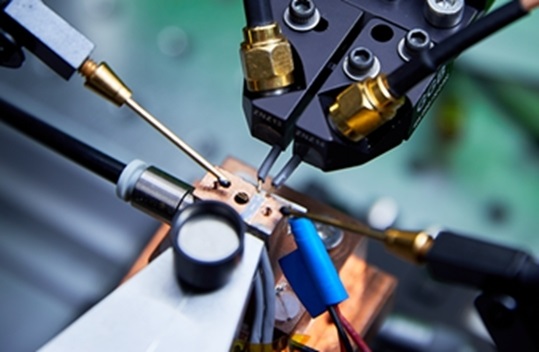CAMBRIDGE, England, Oct. 22, 2021 — Toshiba Europe has developed a chip-based quantum key distribution (QKD) system that could enable mass manufacturing of quantum security technology for a broad range of applications, including Industry 4.0.

A QKD chip under test at Toshiba’s Cambridge Research Laboratory. Courtesy of Toshiba.
For quantum cryptography to become as ubiquitous as the algorithmic cryptography used today, it is important that the size, weight, and power consumption are further reduced, Toshiba Europe said in a press release. This is especially true for extending QKD and quantum random number generators (QRNG) into new domains such as the last-mile connection to the customer or IoT. The development of chip-based solutions is essential to enabling mass-market applications, which will be integral to the realization of a quantum-ready economy, the company said.
Toshiba has developed techniques for shrinking the optical circuits used for QKD and QRNG into tiny semiconductor chips. The circuits are smaller and lighter than their fiber optic circuits, and also consume less power. Many can also be fabricated in parallel on the same semiconductor wafer using standard techniques, allowing them to be manufactured in much larger numbers.
The quantum transmitter chips developed by Toshiba measure just 2 × 6 mm, allowing several hundred chips to be produced simultaneously on a wafer.
“Photonic integration will allow us to manufacture quantum security devices in volume in a highly repeatable fashion,” said Andrew Shields, head of quantum technology at Toshiba Europe. “It will enable the production of quantum products in a smaller form factor, and subsequently allow the roll out of QKD into a larger fraction of the telecom and datacom network.”

The device is reportedly the first complete QKD prototype in which quantum photonic chips of different functionality are deployed. Random bits for preparing and measuring the qubits are produced in QRNG chips and converted in real time into high-speed modulation patterns for the chip-based QKD transmitter and receiver using field-programmable gate arrays (FPGAs).
QKD addresses the demand for cryptography that will remain secure from attack by future supercomputers. A large-scale quantum computer will be able to efficiently solve the difficult mathematical problems that are the basis of the public key cryptography widely used today for secure communications and e-commerce. Protocols used for quantum cryptography can be proven secure from first principles and will not be vulnerable to attack by a quantum computer, or any computer in the future.
Part of the work was funded by the Innovate UK Collaborative R&D Project AQuaSeC, through the Industrial Strategy Challenge Fund.
The research was published in Nature Photonics (www.doi.org/10.1038/s41566-021-00873-0).